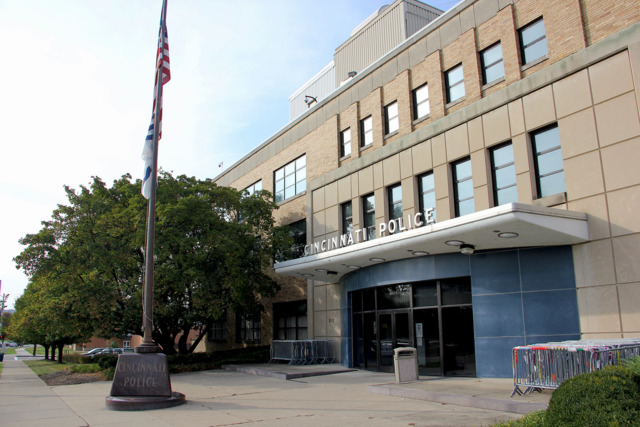A report issued in February by Cincinnati Police officials in response to criticism sheds some new light on ways in which the department is implementing key tenets of the city’s 2002 police reforms, says a panel of experts convened by the city, but it still leaves big areas for concern.
While CPD more clearly articulated its efforts to practice the more collaborative, less aggressive and more precise style of policing called for in the reforms, the department still hasn’t implemented those approaches consistently at the highest levels, experts say.
At the core of the panel’s past critiques of CPD: its implementation of something called Community Problem-Oriented Policing, sometimes simply called problem solving. That approach calls on departments to abandon aggressive traditional policing tactics for so-called Community Problem-Oriented Policing practices, which are meant to engage community stakeholders to zero in on a few perpetrators of serious crimes while reducing arrests and use-of-force incidents.
A report released in January by that panel, headed by criminal justice expert and former court-appointed Collaborative Agreement overseer Saul Green, said CPD hadn’t been doing that in many cases and had strong words for the department. Green’s team also includes University of Cincinnati criminal justice professor John Eck, Columbia University law professor Jeffrey A. Fagan and Joseph Brann, a longtime law enforcement professional who was the founding director of the federal office of Community Oriented Policing Services.
“Taken literally,” the panel wrote of a previous report provided by CPD, “it states that the City of Cincinnati has unilaterally withdrawn from the Collaborative Agreement.”
CPD officials, however, said that they simply hadn’t fully articulated to Green and his team the ways in which they’ve been practicing reforms.
“Based on the feedback offered by the Independent Contractor, CPD recognizes that we could have included additional information to better convey our continued commitment to problem solving in meeting our goals of Community Problem-Oriented Policing,” CPD officials wrote in a supplemental report released Feb. 16. That report contains examples of projects the city says are problem solving efforts, along with positive outcomes brought by those projects.
The department’s report says that CPD hasn’t abandoned Community Problem-Oriented Policing procedures. Instead, they’ve become so embedded in the department’s way of doing business that officers aren’t always aware that the practices are out of the ordinary. Officials do acknowledge in the report that the department hasn’t been documenting its use of problem solving techniques as much as it could.
The experts’ newest report, released March 30, lauds the department for some previously un-articulated projects that follow the new methods detailed in CPD’s February response, but also suggests that the department isn’t careful about how it tracks and measures those efforts.
“There appears to be a lack of attention at higher levels of the organization to ensuring there is an ongoing emphasis on and documentation of problem solving efforts,” the report reads, “a resistance to using or a failure to develop meaningful performance metrics and outcome measures to evaluate the impact and effectiveness of those endeavors, an uncertain commitment to transparency and both internal and external review, and a lack of awareness as to how critically important these tools and data are to informing and educating both staff and the community about which strategies and tactics might then prove to be most effective in contending with recurring problems.”
Further, the department isn’t usually implementing problem solving on a wider scale, according to Green’s team.
“We must note... that all the efforts described in the reports from the districts are what might be called 'beat-level' problem solving efforts,” the March 30 report reads, before noting that some efforts in non-district CPD units like the Criminal Investigations Section seemed to have a wider scope. “Problems obviously come in a variety of sizes, so it is critical for a police department to be addressing the full range of problems that are thrust upon it with commensurate resources.”
The Collaborative Agreement was born out of civil unrest following the 2001 Cincinnati Police shooting of unarmed black 19-year-old Timothy Thomas in Over-the-Rhine and more than a dozen previous police shootings. The U.S. Department of Justice stepped in to mediate an agreement between activist groups like the Black United Front, which had previously filed a lawsuit around police killings, the City of Cincinnati and CPD.
That work resulted in a sweeping agreement that instructed CPD to change the way it policed communities in Cincinnati. Among the biggest items on the to-do list: More than 15 years after that agreement, activists, city officials and CPD announced last year that the city was embarking on a voluntary “refresh” of the agreement.
The 2002 reforms have earned national praise from media outlets, experts and elected officials, though disparities in policing remain in Cincinnati.
Activists say the reports from Green's team show that the city still has work to do.
“These things mean something and they have actions behind them and we need to hold them to that,” Black United Front’s Iris Roley, who was a key player in work to bring the Collaborative together, said of police and city leadership at a recent police accountability forum in Roselawn.
While overall arrests have gone down in the years since 2001 in Cincinnati, that’s followed a national trend. Incidents where an officer shot a citizen have also gone down recently. There were two police-involved shootings last year — one of a white citizen, one of a black citizen, both ruled justified. There were four officer-involved shootings in 2016 — three involving black citizens — and six in 2015. Five of those shootings involved black citizens.
Despite reductions in arrests and shootings, blacks still find themselves in the backs of police cruisers more often than their white counterparts.
In the first half of 2017, roughly 72 percent of adult CPD felony arrests and 63 percent of misdemeanor arrests were of black citizens, according to CPD data, though blacks make up just 42 percent of Cincinnati’s population.
The disparities among juveniles are even more stunning. Ninety-six percent of youths arrested for felonies and 89 percent arrested for misdemeanors by CPD in the first half of 2017 were black, according to CPD data.






